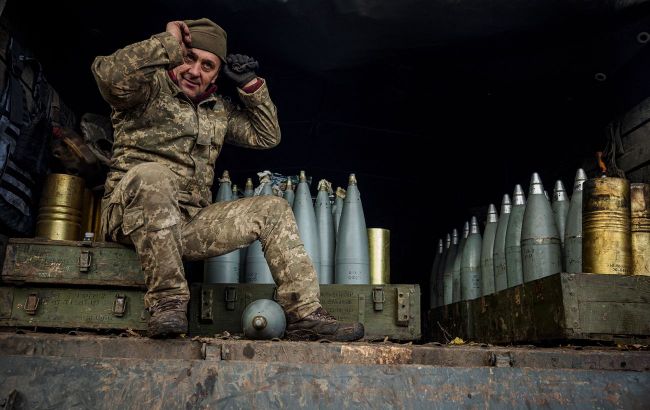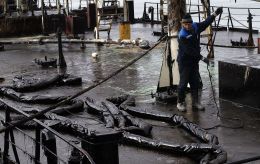Reasons for Ukraine's ammunition shortage and solutions: Expert's opinion
 The issue of a shortage of artillery shells arose due to several reasons (Photo: Getty Images)
The issue of a shortage of artillery shells arose due to several reasons (Photo: Getty Images)
Ukraine is experiencing a shortage of artillery shells and plans to compensate by ramping up production of kamikaze drones. However, whether this will be sufficient to cover the deficit partially also depends on production capacities.
Read more about the reasons behind the artillery shell problem and potential solutions in the material by RBС-Ukraine below.
The material draws from interviews with Oleksandr Tarnavskyi, commander of the Tavria Operational Strategic Group for Reuters, Ivan Havryliuk, Deputy Minister of Defense for BBC, insights from the Institute for the Study of War (ISW), and an exclusive commentary from military journalist and former spokesperson of the General Staff of the Armed Forces of Ukraine, Vladyslav Seleznov.
Why did the deficit arise?
One of the latest to remind us of the acute problem was the commander of the operational-strategic group Tavria, Brigadier General Oleksandr Tarnavskyi. In his interview with Reuters, he stated that Ukrainian defenders lacked artillery shells due to insufficient support from the West.
"There's a problem with ammunition, especially post-Soviet (shells) - that's 122 mm, 152 mm. And today these problems exist across the entire front line," the general said.
However, Tarnavskyi assured that the Ukrainian Defense Forces firmly maintained defensive lines.
In turn, military journalist and former spokesperson of the General Staff of the Armed Forces of Ukraine, Vladyslav Seleznov, mentions in his commentary to RBC-Ukraine that Ukraine has recently experienced a trend where the volumes of military-technical support from our Western partners have significantly decreased.
"Between August and October of this year, we received 90% less military-technical assistance than during the same period last year. The capabilities of the Ukrainian defense-industrial complex cannot fully satisfy all the needs of the Ukrainian Armed Forces," Seleznov says.
The expert explains that the problem is indeed related not only to the turbulent processes occurring within the governments of Western countries.
"It is also linked to the fact that world enterprises producing ammunition have not yet fully switched to wartime production. The current war is the largest in scale on the European continent, and therefore, it consumes a lot of resources," notes Seleznov.
What's the alternative?
Deputy Minister of Defense Ivan Havryliuk, in an interview with the BBC, has noted that Ukraine is ramping up the production of kamikaze drones to compensate for the lack of ammunition.
"As for artillery ammunition, this issue will continue to arise. Therefore, Ukraine decided to address these issues by creating a powerful UAV production facility," he said.
RBC-Ukraine has asked expert Seleznov about the extent to which this mechanism can cover our needs. He emphasizes that it all depends on the volume of production of these same kamikaze drones.
"If we have them in large quantities, then, accordingly, we will partially cover the deficit. However, artillery ammunition and the combat part of the projectile are somewhat larger than the FPV (First Person View) that we can use for effective enemy strikes," the interviewee points out.
Moreover, as explained by the expert, long-term fire points and concrete structures cannot be destroyed by FPV drones. Heavy caliber artillery is needed to transform these enemy defensive structures into piles of debris. Regarding FPV, it is more of a "surgical," a kind of "precision tool" to destroy enemy machinery, weapons, etc.
1:7 ratio
It is evident that both the Russian army and the Ukrainian Defense Forces actively use artillery components to succeed on the battlefield. Unfortunately, the balance of forces and resources is not in favor of the Ukrainian army, the expert explains.
"Because for every Ukrainian shell, there are currently 5-7 enemy ones. Thus, the intensity of enemy fire is higher," said Seleznev.
The expert emphasizes that information about the resource capabilities of the Ukrainian Defense Forces is not often publicized. Therefore, there are very serious reasons behind General Tarnavskyi's statements.
"What to do in this situation? Additional lines, positions, and engineering fortifications need to be created on the battlefield. This will partially protect our soldiers from enemy aviation and artillery. And of course, search for ways to intensify the production of ammunition and work on military-technical communications with our Western partners. Because we need ammunition here and now, not in some distant perspective," believes Seleznov.
How will the lack of ammunition affect the front?
According to analysts at the Institute for the Study of War (ISW), the shortage of artillery shells, combined with delays in Western assistance, could delay future Ukrainian counteroffensive operations.
In particular, General Tarnavskyi has stated that the Ukrainian military is forced to reschedule tasks and make them smaller. The commander has added that "weary Ukrainian troops on the southeastern front have gone on the defensive in some areas but are trying to attack in others."
"Delays in concrete Ukrainian operational planning and the material necessary for counteroffensive preparations will likely in turn delay 2024 counteroffensive operations," ISW believes.
However, Seleznov urges attention not to the statements of analysts and commentators but to the statements of the Ukrainian command and official spokespersons in this context. They possess a full spectrum of information and know precisely what is happening on the battlefield.
Regarding the question of the enemy's shortage of ammunition, the expert suggests that due to weather conditions and imperfect logistics, the Russian forces may feel a shortage.
However, currently, the enemy's army has significantly more resources and capabilities in the defense industry complex. Additionally, one should not forget about significant assistance to the aggressor from North Korea and Iran.

